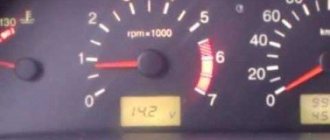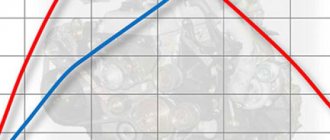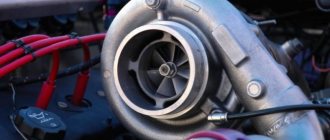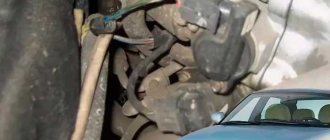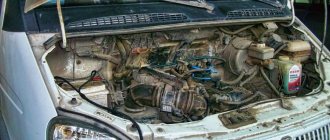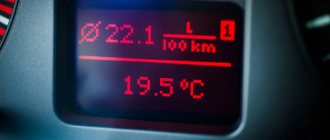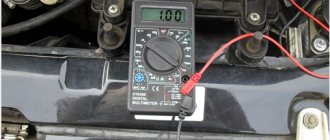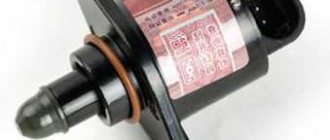Poor quality gasoline is harmful
Many problems when operating the propulsion system of a VAZ car are associated with the use of low-quality gasoline. Leftover gasoline at unreliable gas stations is very dangerous. The entire fuel line, carburetor, and possibly even the engine may need to be flushed. It is quite possible that the units will have to be disassembled, washed, soaked and blown with compressed air.
If circumstances force you to refuel in an unfamiliar place, use caution.
| What to worry about | What results will this give? |
| Try not to use fuel filled in a proven location until the tank is empty. | Let there be at least a mixture of good and risky fuel in the gas tank, and not just questionable fuel - this will reduce the risk. |
| Fill only the minimum amount of fuel. | One that will allow you to get to a proven gas station worthy of your trust. |
| On long trips, carry a cleaning additive with you to add to your gas tank. | It is likely that you will be able to get away with adding the appropriate additive to the fuel tank when using questionable gasoline. It's like getting a flu shot - it boosts your immunity. |
One gas station at an untested gas station, and you face the prospect of serious repair work.
Causes of the problem
Quite often, VAZ 2109 owners are faced with a problem when the carburetor does not hold speed while idling, and the engine simply stalls. There can be many reasons, and they are all united by a number of characteristic features.
The first reason is a clogged idle jet. Even though the fuel supply system has 2 filters (coarse and fine), even one speck may be enough to clog the nozzle.
Also, the fine filter itself may become clogged. This often happens when the filter was not replaced with a new one in time. Less commonly, malfunctions in the idle system occur.
There is no difference at all between the symptoms for any of the causes of the problem. Determining what exactly needs to be cleaned or changed can only be done through a visual inspection or diagnostics.
Also, sometimes the revs not only disappear completely, but also float. At the same time, the VAZ 2109 car does not stall. In this case, to the above reasons, you should add: a faulty solenoid valve or idle speed sensor.
Causes of malfunction
Troubleshooting is an incorrect air-fuel mixture ratio in the combustion chamber or a lack of spark. In this case, the crankshaft may turn with difficulty, or there will be misfires.
Many car enthusiasts started with carburetor engines and therefore know perfectly well why the engine misfires, but not everyone can fix the problem because they don’t know what the problem is. It is worth understanding that the tripping effect occurs due to a disruption in the supply of one of the elements - air, fuel and spark. It is in the systems that are responsible for these elements that we should look for the cause.
So, let's look at the components where you should look for the reason why the VAZ 2109 engine with a carburetor injection system is tripping:
Choke only (carburetor)
#1 wild_wolf
- Users
- 42 messages
- Car make: VAZ 21099
- From: Peter
VAZ 21099 1.5 carburetor The essence of the problem: after visiting a service center under the proud name “AVTODOR” on Komendantsky 50 they made a suspension and sort of cleaned the carburetor and adjusted it, now I ride only on choke and periodically smoke comes out of the pipe + the radiator leaks antifreeze and blue smoke comes out of the exhaust when cold it crashes then disappears, the engine doesn’t hold speed, it stalls (((at 1000 rpm I set it, it starts to float quite actively and stalls, if you pull the choke the rpms are up to 1200-1500, the rpms float less, but the picture is even more fun, 1, 2, 3, then the intersection is neutral rpm 1800 -2000, and sometimes (to put it mildly) at every 4th - 5th intersection it stalls when you release the gas, i.e. threw out neutral, released the gas pedal sharply and everything stalled.
WHAT to do. SAVE
#2 Protva
VIP Member6 065 messages
- Car make: Chevrolet Lanos SX
- From: south Mos. region
#3 Mityai648
Users83 posts
- Car make: I'm waiting for foreign.
- From: MO, Lyubertsy
I'll intervene so as not to create a new topic.
I also often drive around the city on the choke - without it, on a warm car at XX rpm 50
250 float, sometimes 700 return to normal
I've already adjusted the carb several times at the service center, worked magic with the mixture, set the ignition, distributor, spark plugs, etc. - everyone looked. I leave the service center - everything is OK, it holds smoothly at 20 rpm, the acceleration is fast. After about an hour of driving, all adjustments go wrong. Why?
The masters don't know the answer.
#4 another_Igor
Users60 messages
- Car make: VAZ-21099
- From: St. Lenin-Burg
I'll intervene so as not to create a new topic.
I also often drive around the city on the choke - without it, on a warm car at XX rpm 50
250 float, sometimes 700 return to normal
I've already adjusted the carb several times at the service center, worked magic with the mixture, set the ignition, distributor, spark plugs, etc. - everyone looked. I leave the service center - everything is OK, it holds smoothly at 20 rpm, the acceleration is fast. After about an hour of driving, all adjustments go wrong. Why?
Why does the car stall when starting? I have this problem when I start to move it starts to stall.
Guys, this problem is when I start to move it starts to stall, or when the food jerks, the gas flows, but when it’s idling it doesn’t stall normally, guys, what could this happen to anyone?? VAZ 2108. Why does the car stall when starting off?
Similar articles
22 comments on “Why does the car stall when starting. This is the problem when I start to move it starts to stall”
Try changing the fuel and air filters first.
change fuel filter
If it's carb, then unscrew the solenoid valve and blow there from the compressor
The fuel pump gets hot and pumps poorly. try soaking a rag in cold water and put it on the fuel pump or just pour some water on it, if it works fine then change the fuel pump.
Sanyok, eph is responsible for idling, that’s all! and this guy's car idles normally.
injector or carb
I have the same problem now! I thought the carb was checked, it was still the same, most likely it was the fuel pump
Of course, I’m not a seasoned carburetor guy, but it helped me “if the problem is in the carburetor”
Take the carb apart and have a look. This is the kind of hat I had when a piece of the float broke off and went into the hole where the gasoline escapes. Then I changed everything and blew it out and it was no use.
It happened that I changed the fuel pump and blew out the carb at the same time, try it for me on nine
ignition advance vacuum
In short, dude, do as I wrote, if it helps, then don’t get into the carb! There’s no need to get into it again, I’m telling you as an experienced carburetor guy) Change the fuel pump and that’s it. And if it doesn’t help, check the hoses for leaks so that air is not sucked in. It also happens that the float gets stuck and the fuel level in the carb is lower, but this is unlikely.
The mesh in the tank is clogged and that’s it)
All the guys cleaned the carb, changed the pump, it started working normally, but the problem is they won’t idle, thank you)
VAZ 2109: engine stalls while driving and idling
Sometimes such a nuisance happens on the way, the driver finds himself in a situation where the engine of a VAZ 2109 stalls in the middle of the road and it is impossible to start the car further. The most interesting thing in such a situation is that there were no traces of any signs warning (foreshadowing) these problems, the car drove as usual, there was no “sneezing” or “shooting in the muffler.” Since the problem is common, our instructions will tell you what to do in a situation such as a sudden stop of the engine and poor starting. We will consider in detail all the main reasons that cause the engine to stop at idle and while driving. And also the reasons why it does not start when warm and how to solve this kind of problem.
VAZ 2109 carburetor troits when cold - causes of malfunction
The engine “troits” - twitches at idle. You can hear popping noises in the muffler when starting the engine, at “choke”, the speed is stable, without “chuck” on a warm engine the idle speed is unstable until it stops.
Often, unstable engine idle speed is accompanied by increased fuel consumption and loss of power and throttle response.
Let's look at the reasons for unstable engine idling (engine troits) on VAZ 2108, 21081, 21083, 2109, 21091, 21093, 21099 cars with carburetors 2108, 21081, 21083. Here is a list of reasons for the vehicle systems, a more detailed analysis of each of the reasons is given in individual articles available via links in the article.
Attention! If you have never adjusted a carburetor and have no idea how it works, we do not recommend repairing anything yourself. Better contact a qualified technician
Before we begin to consider possible breakdowns, let me say that in most cases, tripping on a cold engine can be associated with:
Carburetor adjustment
If the car is used frequently, the carburetor requires constant maintenance. This does not mean that it needs to be washed externally. This method is suitable if the parts are heavily soiled and their functionality is impaired due to this. Internal cleaning of parts is a must.
The better the owner monitors the cleanliness of his car, the longer its service life will be. To wash parts, it is best to use special rags and brushes. Do not forget that small lint from brushes can get into the parts.
It is important to monitor this constantly, as small debris can damage a large carburetor. Today there are many different services that provide the ability to clean a car using special equipment and appropriate tools.
The work is carried out by qualified specialists.
It is very important for every driver to monitor whether the tachometer needle is jumping or not. After all, it is precisely this that is the most important hint and signal for action.
A tachometer is a special device that can be used to monitor the condition of the carburetor. The tachometer needle will always indicate the reason. Experienced drivers know how the tachometer on a VAZ 21099 carburetor works. There are several key points, knowing which, you can determine the cause of the breakdown.
Installation of a new IAC
Installation of the new device on the VAZ 2109 and 21099 is carried out in the reverse order: connect the wires, put them in place, and fix them with two bolts. But sometimes situations occur when, after replacement, the engine speed still fluctuates and no changes occur. So, in order to avoid such a nuisance, before installation, you should definitely check the new part.
To do this, connect the disconnected sensor to a multimeter. The positive wire goes to the coil, and the negative wire goes to the motor. Next, turn on the ignition and check the instrument readings. If they float around 12 V, then the device is working properly and is ready for use. But if the instrument scale readings show 0 V, then the part is definitely faulty. If, during the same check, the old, broken sensor also shows 12 V, but at the same time, the engine speed fluctuates during its operation, then the old device is working properly and needs cleaning.
The process of cleaning this part includes complete disassembly. Therefore, it is better to entrust this matter to a specialist, since carrying out the cleaning procedure yourself can completely break the device.
Engine stalls at idle
On a VAZ 2109 the engine stalls at idle for the following reasons:
- The most common of them is the idle speed sensor (regulator), on which the idle speed of the engine directly depends
Idle speed sensor (regulator)
- Checking it is quite simple. When the car does not start due to rotation of the starter, then also work with the gas pedal, the engine should start
- In the case when the speed immediately begins to fluctuate, after removing your foot from the gas pedal, 99% out of a hundred, that the reason lies precisely in the regulator, so the price of the issue here is ridiculous
- The solution is simple - replacing the regulator, this takes any VAZ owner a minimum amount of time
- The second most likely reason why the VAZ 2109 engine stalls when idling is a problem with opening the throttle valve
- The cure for such a “disease” is trivial - clean the throttle valve
- When cleaning the throttle valve does not solve the problem, suspicion falls on a malfunction of the throttle position sensor; when it is faulty, the engine will also stall at idle.
- We solve the problem by replacing the TPS, this procedure is not difficult and can be easily done with your own hands
Causes and solutions
When the VAZ 2109 carburetor stalls at idle, that is, when your foot is on the gas pedal, the car works flawlessly, and as soon as you lower it, it stalls, you should look for the cause in the idle speed solenoid valve. To find the reason, you need to understand the meaning of the machine. Thus, the carburetor of the car has an idle system, which consists of a fuel channel with a nozzle, an air channel and a solenoid valve. When the car is idling, fuel moves through a special idle passage into the engine. To ensure that the car operates at idle speed, there are holes on the nozzle.
What kind of malfunction causes the idle speed to disappear?
There may be two reasons:
- Problems with fuel supply at idle.
- There is an air leak in the system, which disrupts the optimal proportion of air and gasoline in the combustible mixture.
In the first case, the responsibility falls on the idle air solenoid valve. If it malfunctions, fuel will not be able to flow into the engine.
To eliminate the cause, you should remove the air filter, from which the cover is then removed. After this, a mini service check is carried out. With the ignition on, remove and place the chip on the valve. The serviceability of the coil is indicated by characteristic clicks that are heard during manipulations. But to be completely sure of serviceability, you should unscrew the valve. To do this, use key No. 13. Then remove the jet and check for contamination. Blowing air through your mouth, see if it passes through it normally. After such a check, you need to close the hole in the EAC (hereinafter the idle speed solenoid valve) with your finger and turn on the ignition. This procedure will blow out any debris that has accumulated in front of the fuel jet, if there is any there.
You should also check the integrity of the rubber seal. If there is damage, deformation or a loose fit, air will be sucked in, which is why the machine will malfunction when idling.
If there is no characteristic click when removing and putting on the chip, then you should check whether there is voltage. If it is missing, you should check the carburetor throttle economizer.
If there is voltage, but there is nothing to replace the valve with (the breakdown occurred on the road), then you can take emergency measures that will allow you to complete the route. To do this, you need to remove the nozzle and break off the plastic needle and put the nozzle in place. In this case, there is no need to put a wire on the EPHH.
If all the manipulations carried out did not help eliminate the malfunction, then the problem lies in air leaks, which are not so easy to detect.
In this case, the procedure is as follows:
- You should check the tightness of the carburetor cover, as well as the serviceability of the paper gasket between them.
- Check all hoses for damage and cracks.
- Check for a plug on the tube located at the rear of the carburetor. If it is missing, make sure that air is not sucked in. To do this, you just need to put your finger on it. If an air intake is detected, then the car is turned off and a bolt is screwed onto a tube of the appropriate diameter, and the other end is put on the carburetor outlet.
What causes it to stall?
If you have a carburetor nine and it does not want to start, the following vehicle malfunctions may be the cause:
- the battery has either already served its purpose or has lost its charge - in this case, the starter can turn, but due to the lack of energy, the ignition is blocked. In case of this breakdown, it will be enough to charge the battery or replace it;
- if the synchronizer sensor is connected incorrectly (the poles of the wires are reversed), you just need to change them from one place to another, checking them before doing so;
- if the valve on the gearbox is depressurized, in this case the car will be in trouble, because gasoline (or its vapors) will enter the receiver and enrich the combustible mixture. To eliminate the malfunction, you need to restore the tightness of the gearbox valve.
A very common problem that drivers of nines encounter is when the car stalls immediately after starting. Sometimes the machine starts working on the third or fourth try, but then starts to misbehave again. You should not ignore such moments. It’s better to take a look and fix the problem right away. In this case, it is better for inexperienced mechanics to go to a service station. Cleaning the throttle valve, adjusting the idle speed or replacing the IAC may help if:
- the car stalls immediately after starting (whether the engine is cold or hot);
- idle speed returns to normal after heavy gas release;
- You can start the car only by using the accelerator;
- When braking hard, the motor turns off.
In order to find the problem, you need to diagnose your car. This procedure will help you determine for sure where and what needs to be repaired.
Defeated tripping at idle — LADA 2115, 1.5 l., 2003 on DRIVE2
I measured the compression, it certainly made me happy and sad at the same time: it was 12-11-11-10. When the outside temperature reaches 20, I’ll start adjusting the valves, they seem to be tight. Well, since the compression is non-zero and more than 10, then the valve is clearly not burned out and the gasket is intact. I breathed a sigh of relief) By the way, if you, like me, are a single repairman, then it’s easy to measure the compression alone) Warm up to operating temperature, unscrew the spark plugs, do something like this with the throttle
We remove the chips from the injectors and the ignition module and most importantly: the red wire, which is also positive, fits into the starter solenoid relay, replace that wire with something like this
Well, then we screw in the compression gauge and connect this wire to the battery positive, the starter turns successfully, the spark plugs and injectors are silent and we calmly take readings.
The syringe has 5 cubes, without a ring, the nozzle fits well with a little tension, there is enough pressure. The injectors were clean, they became even cleaner) Then I put the whole thing back together, started it up and received the long-awaited satisfaction of its successful work)) So, I bought a compression gauge for 500 rubles and a carburetor cleaner with rings for 170 rubles and not a single sensor)) Thank you all for your attention and not hurry up to change everything, the problem can be much smaller and cheaper) If only you can find it)
Replacing the fuel filter yourself
Before performing work, it is necessary to drive the car onto an overpass or pit. After this, you need to find the necessary filter. In this car model, it is located under the bottom of the vehicle behind the fuel tank, next to the muffler. After this, you should unscrew several fittings (pipes). It is best to do this using key number 19 M.
If everything is done correctly, the filter can be easily removed. You just need to remember which side it was installed on. After this, it is enough to put the new filter in the same place in the correct position.
If the VAZ 2114 stalls, there may be other reasons. Therefore, it is worth considering them in more detail.
Diagnostic features
It is worth considering that there are no exact sequential actions by performing which it will be possible to accurately determine the cause of the malfunction. If the power unit stalls only occasionally, then the situation may not be that serious. There is a chance that this is how the vehicle simply reacts to severe frosts. However, if you have recurring problems, you should contact a specialist.
It is best if the mechanic connects a specialized diagnostic device to the car at a car service center. He will determine exactly where the breakdown occurred and which element should be replaced. Of course, if the car owner has enough knowledge, he can identify the problem on his own. But you need to understand that if such a diagnosis was performed incorrectly, this can lead to more serious consequences. In this case, the final repair of the car will be much more expensive. Therefore, you should think several times before saving.
Problems common to both engine types
These malfunctions can be attributed to both injection and carburetor engines, since they occur on both power plants.
- Dirty air filter . If the air purification filter is sufficiently dirty, then air begins to flow in rather small quantities, which leads to oxygen starvation. In this case, it is necessary to replace the filter element and continue to operate the vehicle.
- Ignition system malfunction . First of all, check for the presence of a spark on the high-voltage wires and spark plugs. This requires two people. The first turns the engine using the starter, and the second checks for the presence of a spark. The spark plug is unscrewed and reinserted into the wire. A partner leans the end of the spark plug against the cylinder block at a distance of approximately 5-10 millimeters. If a spark does not appear while the engine is rotating, you need to check the serviceability of the spark plug or armor wire. The absence of a spark on all spark plugs and armor wires indicates a malfunction of the ignition module or coil. The element is replaced, and the spark plugs are cleaned of any deposits that have appeared.
If there was no spark, then the armored wire is not leaned against the cylinder head, but against the spark plug itself, screwed to the block. If a spark appears, then we can say with confidence that the spark plug is faulty.
Attention! When checking the spark, you should not hold onto the body of the car, as you may receive an electric shock of 40 thousand volts. This voltage is not lethal at low current strength, but there is nothing pleasant about it. Also, do not use prolonged sparking as there is a chance of damaging the ignition module or the coil winding insulation.
It is worth noting that the absence of a spark on all spark plugs is accompanied by the absence of signs of engine life, that is, it does not start at all. Therefore, most often, one spark plug or wire fails, which is immediately replaced. Although it is true that even if all spark plugs are in good working order, they still work unstably on your engine. You can try to fix the problem by replacing parts.
- Fuel filter is dirty . It occurs during long-term use of the car, when there are fewer and fewer holes in the filter and the engine performs worse each time. The fuel filter is being replaced.
These are, perhaps, all the reasons why idle speed may fluctuate. As you can see, their diagnosis and elimination methods will not cause any particular difficulties, so this procedure can be performed with your own hands, without the help of car service employees.
Stalls on a hot VAZ 21099, injector
VAZ 21099i, when heated to t=95, stalls and does not start until it cools down almost completely. At the same time, I found out that there was no spark and there was no voltage going to the injectors. The starter turns normally. What could be the reason?
- VAZ Samara starter will not start - 5 answers
- I can’t start the VAZ 21099 from the starter – 5 answers
- A hot VAZ 21099 has trouble starting - 4 answers
- Stalls while driving 21099 – 4 answers
- VAZ 21099 car will not start - 3 answers
Is there no control voltage on the injectors or a common +12? The main relay turns on when the ignition is turned on, does the fuel pump work?
The ignition module is faulty, it overheats and fails, if the 2112 module is an old model, they are very sensitive to voltage drops.
The voltage at the injectors must be measured relative to the ground, they have a total of +12 volts, and the control voltage comes from the ECU (the minus comes from the ECU). On the ignition module + 12 is also relative to ground.
Does the pump run as usual for 3-4 seconds and turn off? First, check all the masses on the body and engine, not only those under the hood, but also those in the cabin. Second, check the connector on the crankshaft sensor, and the sensor itself (the method is described on the internet). If there is no signal from the dpkv, the computer will not send a signal to either the injectors or the ignition module.
Of course it could fly out, but then why does the spark disappear? It seems to me that there is some kind of general problem, for example, voltage loss. Have you checked the presence of voltage +12 relative to ground, where I described above? You also need to check the supply voltage to the ECU, one goes to it constantly from the battery, the other after turning the key. So far I can’t even connect this with the temperature, but if the ignition module is faulty, try unscrewing it from the engine, it’s possible that the problem will appear sooner or later.
I don't quite understand where you measured. You need to measure between the first and fourth and between the second and third terminals on the spark plugs. That is, the windings are 1-4 and 2-3. I won’t tell you the size, just a few kilo-ohms.
There must be megohms between the windings, that is, if the probes are placed at 1 and 2-3, or for example, 2 and 1-4, the resistance should be very high.
But all these measurements are relative, you cannot determine the turn circuit, a cold winding can show one thing, but a hot winding can go wrong.
As for the module input, I don’t know how to diagnose it with an ohmmeter, there is an electronic circuit inside the module and the ohmmeter doesn’t work.
I don’t remember what the symptoms were, but on the two-wheeler I installed an insulator between the engine and the module, and I transferred the heat from the module to an aluminum plate. I can attach a photo later if interested.
Before this, I replaced two modules, which apparently failed due to overheating. Although the plate also heats up, the hand holds it calmly, unlike the heated engine. That’s why I wrote to you above, try to move the module away from the engine so that it doesn’t heat up.
Solved the problem! It was in vain that I paid attention to the previously stripped insulation on the wires going to the injectors; I thought that due to their contact with each other, the ECU was damaged and therefore the spark disappeared even when heating. It turned out that the ignition module was at fault.
I do not agree that measuring at the input terminals does not make sense; it is the RESISTANCE OF THESE OUTPUT THAT PROVIDES INFORMATION TO THE ECU ABOUT THE SERVICEABILITY OR MALFUNCTION OF THE MODULE.
I repeat once again that the resistance on two showed a little more than 17 kOhm (if you look from above, these are the first two on the left), and on the new module the resistance is more than 2 mOhm.
When heated to a certain temperature, the input resistance of the module dropped to a certain value, at which the ECU concluded that the module circuit was short-circuited and turned off the supply of control voltage to it and to the injectors, apparently to prevent gasoline vapors from accumulating in the muffler.
Replaced the ignition module, drove it for two days, started without problems! Thanks to everyone who responded, your advice helped me find a solution to my problem!
Source
The cause of a stalled engine is a power supply failure
In this type of problem, 3 reasons may be involved:
- Poor contact with the terminals of the new battery;
- Detection of poor contact or breakdown along the entire length of high-voltage wires;
- The appearance of malfunctions in the generator or ignition coil system of the car.
If the problem lies in damp high-voltage wires, then it is best to replace them completely along with the battery contacts. If the terminals make poor contact, you need to carefully clean them with sandpaper and try to reconnect them. If the generator is found to be inoperable, the problem usually boils down to problems in the following parts:
- Broken timing belt;
- There is a malfunction inside the housing of the unit itself.
A problem with the generator is easily detected when the corresponding indicator on the dashboard turns on. In addition, if there is insufficient energy supply, the backlight of the on-board panel will gradually fade, and a set of other diagnostic sensors will show incorrect values.
Advice: if when you press the gas the car jerks, then stalls and cannot start, then the problem is related to the failure of the ignition coils. It is best to replace these parts in a car service using special equipment.
From the list of reasons that are directly related to the car engine, you need to move on to problems that arise in the fuel and air supply systems, as well as malfunctions of components responsible for exhaust gas removal.
Ignition coil
timing belt
VAZ Samara does not start when hot
When it's hot it starts as if on one cylinder, when when it's cold it's a half-poke. I carried out 3 diagnostics in different services, but no fault was shown.
Replaced the fuel pump, replaced the Bosch brains. You can start it hot if you disconnect the temperature sensor, which turns on the radiator cooling rotator; the sensor was also changed.
READ The fuel pump of the VAZ 2106 carburetor does not pump
Regulator XX
This is one of the fairly common reasons why the VAZ 2114 injector
stalls at idle. Regulators called XX or IXX are special devices that help control engine speed at idle. For the power unit to function properly, some air must pass inside. It, in turn, is detected by the mass air flow sensor, and the fuel controller supplies fuel based on sensor readings. Also, the number of revolutions is controlled by the DPKV. But it is the XX regulator that is responsible for the air supply, regardless of the operation of the air valve.
If an IAC system is installed in the car, then, as a rule, the car owner does not need to warm up the engine for a long time before starting to drive. However, this type of regulator is not capable of self-diagnosis. Therefore, if it fails, the VDO VAZ 2114 dashboard does not notify the driver that this unit needs to be checked.
Injection system
If you contact a specialized service center, specialists will definitely check this unit for serviceability. Therefore, when self-diagnosis, this is also taken into account. Often errors in the operation of the power unit are associated with hydraulics. Some of its parts may work correctly, but if the so-called coking of the injectors occurs, then problems cannot be avoided. As a rule, the cause of this phenomenon is low quality fuel. If it contains impurities that cannot dissolve, then all these particles begin to settle on the injection elements. In the first few minutes of engine operation, this problem becomes most obvious.
Although car owners often complain that the car stalls in neutral, engineers have not been able to improve the injectors. It is impossible to completely get rid of sedimentation. In this case, problems often arise not only with cold, but also with hot injectors.
